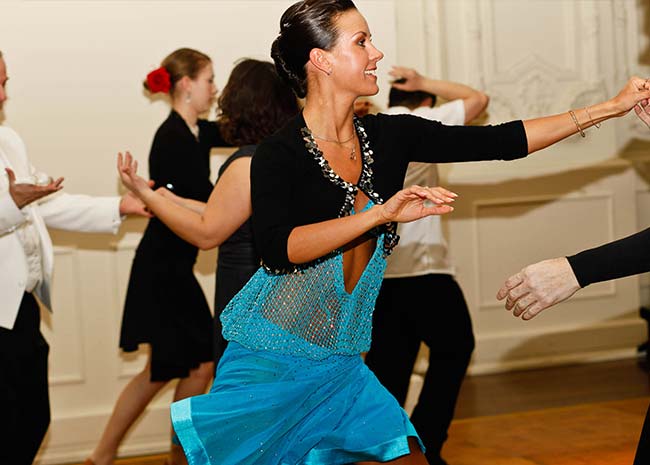Ballroom Turns, and How to do Them Properly, Part 2

Last time, we looked at three common ballroom turns we encounter at the local dance hall or Latin club. We also learned valuable exercises to help each turn become less nerve-wracking, and a lot more fun. Now, let’s move on to some of the more challenging turns you might face.
Chaine Turns
Added to patterns like the foxtrot sway step, these turns require greater balance and control, because they are made with feet together (they are also sometimes called ‘pencil turns’).
How to practice:
- Point the right foot side without weight. Rotating that foot 1/4 right, change weight onto the ball.
- Close the hip, chest, and left foot to the right foot, making a 1/2 turn right with feet together. Change weight to the LF and let the left heel brush the floor to stop the turn, if necessary.
- Make a last 1/4 rotation right and step side with the RF. Repeat in the other direction.
Reverse (left) and Natural (right) Turns
The core movement of the waltzes, the secret to these turns lies in correct foot and body rotation to get around your partner. When waltzing, there’s no room for a ‘polite’ turn. The outside partner (the one who must travel the most to complete the turn) needs to move through their partner’s space to get around in time – and their partner needs to move aside to give them room.
How to practice:
- Standing with feet apart, mime some practice baseball swings. Feel your body rotate back and forth as you swing the ‘bat’ across your body. Keep your shoulders level.
- Take a ballroom frame. With feet together, take a step forward with the LF, swinging your frame to create a 1/8 turn to the left. The toes of the moving foot should face the same direction as the hips and shoulders.
- Brushing the thighs, make another 1/8 turn left and step side with the RF. Close with the LF.
- Step back with the RF, while making another 1/8 left swing of the frame. Step side and close, making a 1/8 turn left as before.
- Repeat, and practice turning to the right. Try increasing the momentum of the swing to create 3/8 over the three steps, so the turn becomes less of a box and more a giant circle.
Heel Turns
This silver-level turn is by far the most challenging, but it too can be conquered with a bit of time and elbow-grease. Certainly it will help your movement in foxtrot and waltz, especially in Standard.
How to practice:
- Take a step back with the LF, letting your weight rock back to the heel without losing balance altogether, and closing the RF to the LF without weight. Try and hold for a moment before putting the RF down.
- Repeat the above exercise, but this time add a 1/4 turn right on the left heel as the feet close. Finish with your weight on the right heel.
- Change your weight to the ball of the RF and step forward with the LF. Hold the RF back without weight.
- Repeat, stepping back and turning on the right heel, closing with the LF, and turning back to your original direction. Alternate until you are comfortable in both directions.
You now know how to take some of the most common ballroom turns and make them easy and comfortable. And with knowledge – and practice – comes confidence.


Pingback: Ballroom Turns, and How to do Them Properly, Part 1 | Joy of Dance
April 13, 2018 1:24 amPingback: How to Ballroom Dance Efficiently | Joy of Dance
April 19, 2018 6:09 pm